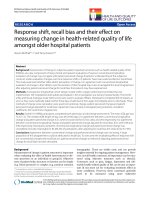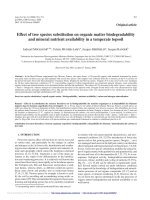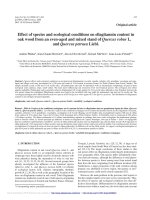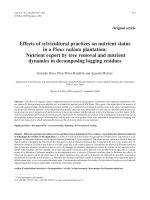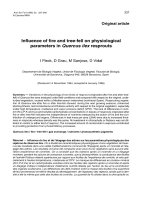Influence of Zn, Fe and B applications on nutrient availability in soil at critical growth stages of maize (Zea mays) in vertisol of Marathawada region of Maharashtra, India
Bạn đang xem bản rút gọn của tài liệu. Xem và tải ngay bản đầy đủ của tài liệu tại đây (183.06 KB, 7 trang )
Int.J.Curr.Microbiol.App.Sci (2019) 8(1): 206-212
International Journal of Current Microbiology and Applied Sciences
ISSN: 2319-7706 Volume 8 Number 01 (2019)
Journal homepage:
Original Research Article
/>
Influence of Zn, Fe and B Applications on Nutrient Availability in
Soil at Critical Growth Stages of Maize (Zea mays) in Vertisol of
Marathawada Region of Maharashtra, India
S.T. Daphade, G.R. Hanwate and P.H. Gourkhede*
Department of Soil Science and Agriculture Chemistry, Vasantrao Naik Marathwada Krishi
Vidyapeeth, Parbhani-431402 (M.S.), India
*Corresponding author
ABSTRACT
Keywords
Nutrient
availability, Critical
growth stages and
maize
Article Info
Accepted:
04 December 2018
Available Online:
10 January 2019
The experiment was conducted during Kharif 2017-18 to study the “Influence of Zn, Fe
and B applications on nutrient availability in soil at critical growth stages of maize crop in
Vertisol of Marathawada Region of Maharashtra” at the research farm, Department of Soil
Science and Agricultural Chemistry, College of Agriculture Badnapur. The experiment
was planned in randomized block design with nine treatments with three replications in
randomized block design. The treatment consists of T 1 RDF (150:75:75 NPK kg ha-1), T2
(RDF + ZnSO4), T3 (RDF + FeSO4), T4 (RDF + Borax), T5 (RDF + ZnSO4 + FeSO4),
T6(RDF + ZnSO4 + Borax), T7 (RDF + FeSO4+ Borax), T8 (RDF + ZnSO4 + FeSO4 +
Borax),T9 (RDF + Foliar application of grade II micronutrient application at 45 DAS).The
results emerged out clearly indicated that nutrient availability in soil was increased due to
application of micronutrients. It was inferred from the results that application of RDF +
ZnSO4 @ 20 kg ha-1 + FeSO4 @ 20 kg ha-1+ Borax @ 10 kg ha-1 found superior over only
N P and K application i.e. RDF (150:75:75 N, P 2O5 and K2O kg ha-1).
Introduction
Maize is an important cereal crop of the world
as well as of India. Maize crop is grown next
to wheat and rice in the world. In India, it is
cultivated over an area of 92.32 lakh hectares
with an annual production of 236.73 lakh
tonnes having an average productivity of more
than 2564 kg ha-1. In Maharashtra it occupies
an area of 10.59 lakh hectares with total
production of 22.03 lakh tonnes having an
average
productivity
of
more
than
-1
2080 kg ha
Micronutrients are essential for crop
production in the present situation of soil
fertility and their deficiency drastically affects
the growth, metabolism and reproductive
phase of crop plants, animal and human
beings. Micronutrient deficiencies in crop
plants are widespread because of increased
micronutrient demand from intensive cropping
practices and adaptation of high-yielding crop
cultivars, enhanced crop production on
marginal soils that contain low levels of
essential micronutrients, increased use of high
analysis fertilizers with low amounts of
206
Int.J.Curr.Microbiol.App.Sci (2019) 8(1): 206-212
micronutrients, decreased use of animal
manures, composts and crop residues, use of
soils low in micronutrient reserves, use of
liming in acid soils, involvement of natural
and anthropogenic factors that limit adequate
supplies and create elemental imbalance in
soil Fageria et al., (2002). Shukla and Behera
(2011) reported that as much as 48, 12, 5, 4,
33, 13 and 41 per cent soils in India are
affected with deficiency of Zn, Fe, Mn, Cu, B,
Mo and S respectively. In India, the trends of
micronutrient deficiencies are now changing.
Instead of single nutrient deficiency, cluster of
micronutrient deficiencies are emerging fast in
vast areas. This suggests that increasing multimicronutrients deficiencies in soil and crops
not only affect the crop productivity, but also
create malnutrition and health problems. In
experiments with rice-wheat, sesame-wheat,
pigeon pea-wheat, maize-wheat, groundnutwheat and sorghum (Fodder)wheat cropping
systems, the addition of S + Zn + B in
balanced fertilization schedule increased N,P
and K utilization efficiency which highlights
the role of micronutrients in enhancing
macronutrient use efficiency. Based on the
results of large number of field trials (4144),
Katyal (1985) concluded that at least in two
out of three experiments, treatment with Zn
fertilizer was necessary to derive optimum
benefit from NPK fertilizers.
Micronutrients are trace elements which are
needed by the maize crop in small amounts
and play an active role in the plant metabolic
functions in shortage of which show
deficiency symptoms and crop yields are
reduced, they are therefore to be added into
the soil before crop planting or applied
directly to the crop to increase maize
productivity. Adhikari et al., (2010) revealed
in order to evaluate the effects of
micronutrients (B, Zn, Mo, S and Mn) on the
grain production of maize (var. Rampur
Composite), series of field experiments were
conducted during the winter season of three
consecutive years (2007 to 2009) in the acidic
soil condition (5.1 pH) at National Maize
Research Programme (NMRP), Rampur. The
highest grain yield (5.99 t ha-1) was recorded
with the crop which was supplied with all
micronutrients (B, Zn, S, Mn and Mo applied
in combination with NPK fertilizers at
120:60:40 kg ha-1 which produced almost 171
% higher grain yield than those with control
plot (2.21 t ha-1) and 3.78 t ha-1 of additional
grains over NPK treated crop.
Materials and Methods
The experiment was conducted during Kharif
2017-18 at the research farm, Department of
Soil Science and Agricultural Chemistry,
College of Agriculture Badnapur. The
experiment was conducted to study the effect
of Zn, Fe and B on nutrients availability at
critical growth stage of maize crop planned in
randomized block design with nine treatments
with three replications. The chemical
composition of experimental plots indicated
that the soil was low in available nitrogen (126
kg ha-1), high in available phosphorus (26.40
kg ha-1), very high in available potassium
(540.26 kg ha-1) and alkaline having pH 8.1.
The concentration of zinc, iron and B in
experimental plots was 0.3 ppm, 2.3 ppm and
0.7 ppm respectively. The dose of the NPK
along with Zn, Fe and B for maize was
worked out according to the present
recommendation of maize hybrids in
Marathwada region. The 100% NPK dose in
kg ha-1 worked out was 100:75:75 NPK kg/ha
for maize crop. The doses for zinc, iron and
boron were framed by applying ZnSO4 @ 25
kg ha-1, FeSO4 @ 25 kg ha-1 and borax @ 10
kg ha-1, respectively. Fertilizer application was
made as per the treatments. Full dose of
phosphorus, potash and half dose of nitrogen
were applied at sowing as basal application.
The remaining dose of nitrogen was top
dressed at 30 DAS depending upon the
occurrence of rains. Full dose of zinc, iron and
boron were applied at sowing.
207
Int.J.Curr.Microbiol.App.Sci (2019) 8(1): 206-212
Maize variety Markiv-6202(Hybrid) was sown
at the seed rate of 15 kg ha-1 at spacing of 60
cm × 20 cm. Shallow furrows were opened
and seeds were sown manually by using
dibbling method at the depth of 5 cm. The
sample from each plot was collected from a
depth of 0-30 cm at the time of sowing and at
harvest. The sample was air dried in shade.
The remaining soil sample was ground using
wooden pestle and mortar and passed through
2 mm sieve, and then cleaned sample was
preserved in polythene bags for further
analysis. Available nitrogen in soil was
estimated by alkaline permanganate oxidation
methods, available phosphorus was estimated
by using 0.5 M NaHCO3. The potassium
content in the extract was determined by flame
photometer, Available zinc and iron content in
soil was extracted with DTPA (Diethylene
Triamine Penta acetic Acid) reagent and
Available boron in the soil was extracted by
the procedure of Berger and Truog.
Results and Discussion
Available N
The data furnished in Table 1 revealed that
significantly highest availability of N at
tasseling stage 191.57 kg ha-1, cob initiation
165.03 kg ha-1and harvesting stage156.51 kg
ha-1was found inT8 which was at par with
treatment T5, T6, T7 and T9. The decline in the
available N status of the soil might be
attributed to the utilization of N for growth of
maize (Brar et al., 2006). Elayaraja et al.,
(2014) reported that application of Zinc
sulphate at 30 kg/ha + RDF to groundnut
increased nitrogen availability in soil.
Available P2O5
The data furnished in Table 1 revealed that
significantly highest Availability of P at
tasselling stage 48.84 kg ha-1, cob initiation
stage44.41 kg ha-1and at harvesting stage
37.87 kg ha-1 was found in T8 which was at
par with T9. Rao and Shukla (1996) reported
that application of micronutrients increased
the P availability in sandy clay loam soil. The
increased rates of it decreased the P
availability (Nayak and Gupta, 2002).
Available K2O
The data furnished in Table 1 revealed that
significantly highest availability of K at
tasselling stage 601 kg ha-1, cob initiation
stage582.62 kg ha-1 and harvesting
stage567.20 kg ha-1 was found in treatment T8
which was at par with treatment T5, T6, T7 and
T9. Latha (2001) observed that the availability
of K in the soil was significantly increased by
zinc nutrition, highlighting the positive
interactive effect between Zn and K.
Application of 25 kg ZnSO4 ha-1 registered the
highest values for available K in the soil at
maize harvest. Dhakshinamoorthy (1977)
reported that available K increased with
increased levels of Zn up to 10 mg kg-1,
beyond that level, there was a decrease of
available K content in soil.
Available Zn
The data furnished in Table 2 revealed that
significantly highest availability of Zn at
tasselling stage 1.55 mg kg-1, 1.29 mg kg-1 and
harvesting stage1.38 mg kg-1) found inT8
which was at par with treatment T9. Khurana
et al., (2002) observed a spectacular response
of maize to Zn and Fe application.
Dangarwala et al., (1983) reported that the
combined application of 1 kg B along 5 kg Zn
ha-1 exhibited higher available Zn (0.87 to
2.93 mg kg-1). According to Gayatri and
Mathur (2007) the application of 100 % NPK
+ Zn increased the Zn content of soil by 4.94
per cent over 100 % NPK alone at the harvest
of maize.
208
Int.J.Curr.Microbiol.App.Sci (2019) 8(1): 206-212
Table.1 Effect of Zn, B and Fe on Availability of N P2O5 and K2O in soil at critical growth stages of maze
Treatments
Availability of N (Kg/ha)
Availability of P2O5 (Kg/ha)
Availability of K2O (Kg/ha)
At
At Cob
At
At
At Cob
At
At
At Cob
At
Tasseling initiation harvesting Tasseling initiation harvesting Tasseling initiation harvesting
T1- RDF
134.32
116.43
98.51
26.20
19.51
17.23
529
503.23
487
T2- RDF+ZnSO4
138.37
149.66
132
36.53
28.38
25.06
549.64
521.57
513.70
T3- RDF+FeSO4
165.23
144.10
128.52
35.38
26.41
23.07
543.5
526.13
518.12
T4- RDF+Borax
168.56
146.3
134.25
37.01
29.28
24.40
569.12
547.25
538.10
T5- RDF+ZnSO4+FeSO4
179.35
157.06
142.51
40.16
34.25
29.92
558.98
539.45
526
T6- RDF+ZnSO4+Borax
187.61
165.40
150.21
44.51
36.41
31
578.23
557.34
542
T7- RDF+FeSO4+Borax
181.13
159.36
137.81
41.73
35.48
29
573.10
551.32
540
T8- RDF+ZnSO4+FeSO4+Borax
191.57
168
156.51
49.84
44.41
37.87
601
582.62
567.20
188.03
165.03
153.62
48.41
42.25
34.22
594.19
578.16
561.80
T9- RDF+Foliar application of
Micronutrients
SE ±
5.56
4.67
4.10
4.36
4.17
3.67
14.3
16.03
15.38
CD at 5%
16.74
14.06
12.34
13.13
12.58
11.07
43.06
48.26
46.32
209
Int.J.Curr.Microbiol.App.Sci (2019) 8(1): 206-212
Table.2 Effect of Zn, B and Fe on Availability of Zn, B and Fe in soil at critical growth stages of maze
Treatments
Availability of Zn (Mg/kg)
Availability of B (Mg/kg)
Availability of Fe (Mg/kg)
At
At Cob
At
At
At Cob
At
At
At Cob
At
Tasseling initiation harvesting Tasseling initiation harvesting Tasseling initiation harvesting
T1- RDF
0.73
0.64
0.57
0.43
0.35
0.26
2.98
2.81
2.70
T2- RDF+ZnSO4
1.32
1.26
1.15
0.49
0.42
0.31
3.37
3.16
3.01
T3- RDF+FeSO4
0.87
0.78
0.70
0.47
0.39
0.29
3.58
3.27
3.17
T4- RDF+Borax
0.89
0.78
0.71
1.04
0.93
0.82
3.41
3.23
3.08
T5- RDF+ZnSO4+FeSO4
1.35
1.24
1.19
0.57
0.46
0.34
3.63
3.38
3.19
T6- RDF+ZnSO4+Borax
1.39
1.27
1.23
1.09
0.98
0.85
3.69
3.42
3.20
T7- RDF+FeSO4+Borax
1.38
1.26
1.21
1.08
0.96
0.84
3.59
3.51
3.17
T8- RDF+ZnSO4+FeSO4+Borax
1.55
1.29
1.38
1.20
1.12
0.98
3.90
3.63
3.24
T9- RDF+Foliar application of
1.51
1.27
1.33
1.14
1.06
0.93
3.87
3.56
3.21
Micronutrients
SE ±
0.03
0.03
0.03
0.02
0.02
0.02
0.10
0.09
0.09
CD at 5%
0.09
0.09
0.09
0.06
0.06
0.06
0.31
0.27
0.29
210
Int.J.Curr.Microbiol.App.Sci (2019) 8(1): 206-212
Available B
FeSo4+ Borax.
The data furnished in Table 2 revealed that
the significantly highest availability of B at
tasselling stage 1.20 mg kg-1, cob initiation
stage1.12 mg kg-1 and at harvesting stage 0.98
mg kg-1 whereas lowest availability of Bwas
found in treatment T1.
References
Adhikary, B. H., J. Shrestha and Baral B.R.
2010. Effects of micronutrients on
growth and productivity of maize in
acid soil. International Research
Journal of Applied and Basic
Sciences,1(1): 8-15.
Brar, B.S., N.S. Dhillon, D.S. Benipal, J.
Singh and M.S. Mavi. 2006. Balanced
use of inorganic fertilizers and FYM
for higher crop yields and better soil
health in maize–wheat cropping
system. J. Res. Punjab Agric. Univ.,
43(2): 104-107.
Chaudhary, D.R. and Shukla, L.M. (2004).
Boron status of arid soils of western
Rajasthan in relation to their
characteristics. J. Indian Soc.
Dangarwala, R. T., Trivedi B. S., Patel M. S.
and P. M. Mehta. 1983. Micronutrient
research
in
Gujarat.
Gujarat
Agricultural University, Anand.
Das, D.K. 2000. Micronutrients- Their
behaviour in soils and plants. Kalyani
Publications, New Delhi.
Dhakshinamoorthy, M. 1977. Studies on the
effect of zinc and copper on the yield
and quality of SM 50 brinjal. M.Sc.
(Ag.) thesis. Tamil Nadu Agricultural
University, Coimbatore
Gayatri, V and Mathur A. K. 2007. Effect of
continuous application of organic and
inorganic fertilizers on micronutrients
status in Maize- Wheat system on
typic Ustochrept. Asian J. Soil Sci.,
2(2): 146-149.
Gayatri, V and Mathur A. K. 2007. Effect of
continuous application of organic and
inorganic fertilizers on micronutrients
status in Maize- Wheat system on
typic Ustochrept. Asian J. Soil Sci.,
2(2): 146-149.
Gupta, P. K. and Vyas K. K. (1994). Effect of
Similar result found by Chaudhary and
Shukla (2004) in arid soils of western
Rajasthan. Das (2000) reported that the
amount of DTPA extractable Fe and Mn was
found to decrease with B application while
that of Cu and Zn increased with B
application. Renukadevi (2000) reported that
the application of 1 kg B along 5 kg Zn ha-1
increased the B availability from 0.31 to 0.54
mg kg-1. Nirmale (1991) reported that the
available boron ranged from 0.18 to 0.37 mg
kg-1 in soil. There was steady decrease with
depth showing relatively more accumulation
of available boron at surface layers.
Available Fe
The data furnished in Table 2 revealed that
significantly highest availability of Fe at
tasselling stage 3.90 mg kg-1, cob initiation
stage and at harvesting stage3.24 mg kg-1was
found in treatment T8 which was at par with
treatment T5, T6, T7 and T9 whereas lowest
availability of Fe was found in treatment
T1.The lowest availability of Fe (2.70 mg
kg-1) was found in treatment T1. Similar
results were found by Reddy et al., (2007) on
pigeon pea. Gupta (1994) reported that
addition of NPK along Zn increased the
available Zn, Fe, Mn and Cu as compared to
control.
In conclusion influence of Zn, Fe and B
application on nutrient availability in soil at
critical growth stages of maize concluded that
nutrient availability of nitrogen, phosphorous,
potassium and micronutrients in soil increased
with the application of RDF + ZnSo4 +
211
Int.J.Curr.Microbiol.App.Sci (2019) 8(1): 206-212
phosphorus, zinc and molybdenum on
the yield and quality of soybean.
LegumeResearch. 17(1): 5-7.
Katyal, J.C. 1985. Research achievement of
the All India Coordinated Scheme of
micronutrients in soils and plants.
Fert. News. 30: 67-80.
Khurana, M.P.S., Bansal, R. L. and Bhati D.
S. 2002. Managing zinc and iron in
Kharif crops. Intensive Agriculture.
November – December. pp. 23-25.
Nayak, A.K. and Gupta, M.L. 2002. Influence
of phosphorus, zinc and organic
matter interaction on yield prediction
in wheat. J. Indian Soc. Soil Sci., 48:
194-196.
Nirmale, S. P. (1991). Boron status of soils
farm Parbhani district. M.Sc. nitrogen
in soil. Curr. Sci., 25: 259.
Rao, C.P. and Shukla, D.N. 1996. Interaction
of Zn with different sources and levels
of phosphorus on growth and yield of
rice. Oryza, 34(3): 229-233.
Reddy, M.M., Padmaja. B., Malathi.S. and
Rao.L.J.
2007.
Effects
of
micronutrients on growth and yield of
pigeonpea.
Journal
of
SAT
Agricultural Research, 5(1): 1-3.
Renukadevi, A. 2000. Studies on the use of
Agribor as a source of boron for
sunflower - Maize cropping sequence
in Inceptisols. M.Sc. (Ag.) Thesis
submitted to Tamil Nadu Agricultural
University, Coimbatore - 3.
Shukla, A. K., and Behera, S. K. 2011. Zinc
management in Indian agriculture:
Past, present and future. Indian
Journal of Fertilizer, 7(10): 14–33.
How to cite this article:
Daphade, S.T., G.R. Hanwate and Gourkhede, P.H. 2019. Influence of Zn, Fe and B
Applications on Nutrient Availability in Soil at Critical Growth Stages of Maize (Zea mays) in
Vertisol of Marathawada Region of Maharashtra. Int.J.Curr.Microbiol.App.Sci. 8(01): 206-212.
doi: />
212



![developing and hosting applications on the cloud [electronic resource]](https://media.store123doc.com/images/document/14/y/sx/medium_sxb1401382082.jpg)
